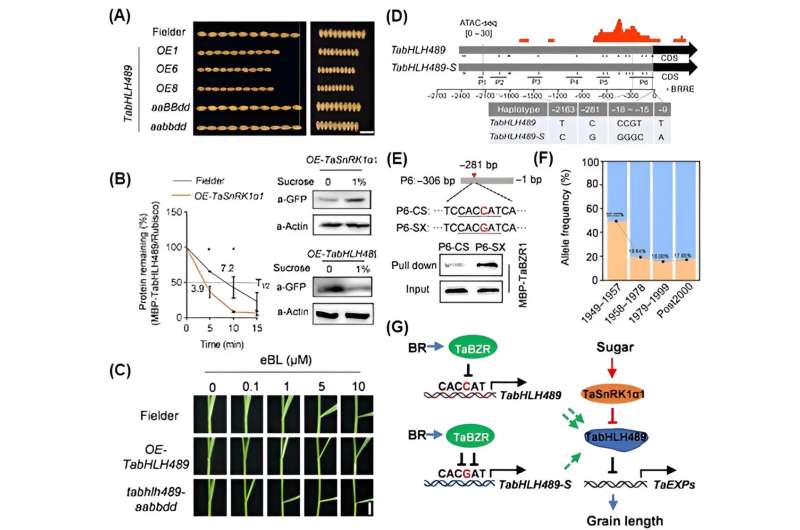Grain size plays a central role in determining wheat yield, and precise regulation of grain development has emerged as a key strategy for increasing yields in several staple crops such as rice and maize. However, the genetic basis and potential molecular regulatory mechanisms governing critical aspects of wheat grain development have remained elusive, creating a bottleneck in the quest to increase wheat yield.
In a recent collaborative study published in Plant Biotechnology, researchers led by Prof. Xiao Jun from the Institute of Genetics and Developmental Biology of the Chinese Academy of Sciences, together with Prof. Bai Mingyi of Shandong University, have identified a gene module that regulates grain length in wheat, providing new insights into how the interaction between brassinosteroid (BR) and sugar signals influences grain size.
The researchers used a combination of genome-wide association studies and linkage analysis to pinpoint an atypical helix-loop-helix transcription factor, TabHLH489-D1, significantly correlated with grain length in wheat. TabHLH489-D1 and its homologous genes were found to reduce both grain length and thousand-grain weight.
They revealed that TaSnRK1α1 facilitates the degradation of TabHLH489 through phosphorylation, thereby promoting the elongation of seed coat cells during the early stages of wheat grain development. Sugar, in turn, induces the accumulation of TaSnRK1α1 protein, which further enhances the degradation of TabHLH489 and collectively regulates wheat grain development.
In addition, TabHLH489 was found to be a negative regulator of the plant hormone BR, and knockout of TabHLH489 increased BR sensitivity in wheat. In wheat mutants with the BR receptor Tabzr1 and overexpression of the BR-negative regulator kinase TaSK2, increased expression of TabHLH489 expression is associated with shorter wheat grains and a decrease in thousand-grain weight.
Conversely, in TaSK2 knockout mutants and plants with overexpressed TaBZR1, a reduction in TabHLH489 expression leads to longer wheat grains and an increase in thousand-grain weight.
Notably, TaBZR1 directly interacts with the TabHLH489 promoter and has a suppressive effect on its expression. Natural variation in the TabHLH489-D1 promoter region affected TaBZR1 binding, decreased TabHLH489-D1 expression, and consequently increased grain length.
This study successfully cloned the key gene TabHLH489 and elucidated its role in regulating wheat grain length. The identification of a gene functional module that regulates wheat grain size and the elucidation of the regulatory mechanisms of BR and sugar on TabHLH489 at both the transcriptional and protein levels mark a significant milestone.
The results not only offer important theoretical support, but also provide valuable allelic gene resources for future wheat breeding efforts.
More information:
Jinyang Lyu et al, The TaSnRK1‐TabHLH489 module integrates brassinosteroid and sugar signalling to regulate the grain length in bread wheat, Plant Biotechnology Journal (2024). DOI: 10.1111/pbi.14319
Provided by
Chinese Academy of Sciences
Citation:
Researchers reveal impact of brassinosteroid and sugar signal on wheat grain size regulation (2024, March 29)
retrieved 29 March 2024
from https://phys.org/news/2024-03-reveal-impact-brassinosteroid-sugar-wheat.html
This document is subject to copyright. Apart from any fair dealing for the purpose of private study or research, no
part may be reproduced without the written permission. The content is provided for information purposes only.


